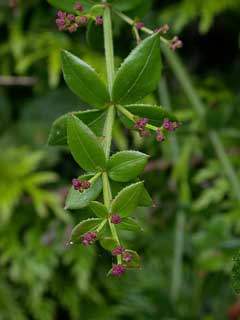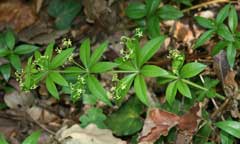 |
|
www.flickr.com/photos/84474308@N00 |
 |
| http://commons.wikimedia.org/wiki/User:Franz_Xaver |
Translate this page:
Summary
Physical Characteristics

 Rubia peregrina is an evergreen Perennial growing to 0.1 m (0ft 4in).
Rubia peregrina is an evergreen Perennial growing to 0.1 m (0ft 4in).
See above for USDA hardiness. It is hardy to UK zone 7. It is in leaf all year. The species is hermaphrodite (has both male and female organs).
Suitable for: light (sandy) and medium (loamy) soils. Suitable pH: mildly acid, neutral and basic (mildly alkaline) soils. It can grow in semi-shade (light woodland) or no shade. It prefers dry or moist soil. The plant can tolerate maritime exposure.
UK Hardiness Map
US Hardiness Map
Synonyms
Plant Habitats
Woodland Garden Sunny Edge; Dappled Shade; Hedgerow;
Edible Uses
References More on Edible Uses
Medicinal Uses
Plants For A Future can not take any responsibility for any adverse effects from the use of plants. Always seek advice from a professional before using a plant medicinally.
Abortifacient Aphrodisiac Diuretic Emmenagogue
Abortifacient, aphrodisiac, diuretic, emmenagogue[46, 61].
References More on Medicinal Uses
The Bookshop: Edible Plant Books
Our Latest books on Perennial Plants For Food Forests and Permaculture Gardens in paperback or digital formats.

Edible Tropical Plants
Food Forest Plants for Hotter Conditions: 250+ Plants For Tropical Food Forests & Permaculture Gardens.
More

Edible Temperate Plants
Plants for Your Food Forest: 500 Plants for Temperate Food Forests & Permaculture Gardens.
More

More Books
PFAF have eight books available in paperback and digital formats. Browse the shop for more information.
Shop Now
Other Uses
Dye
A red dye is obtained from the roots[4].
Special Uses
References More on Other Uses
Cultivation details
Prefers a loose moist leafy soil in some shade[200]. Tolerates dry soils but quickly becomes scorched when growing in full sun[200]. Plants grown in fertile well-limed soils produce more pigment in the root[169].
References Carbon Farming Information and Carbon Sequestration Information
Temperature Converter
Type a value in the Celsius field to convert the value to Fahrenheit:
Fahrenheit:
The PFAF Bookshop
Plants For A Future have a number of books available in paperback and digital form. Book titles include Edible Plants, Edible Perennials, Edible Trees,Edible Shrubs, Woodland Gardening, and Temperate Food Forest Plants. Our new book is Food Forest Plants For Hotter Conditions (Tropical and Sub-Tropical).
Shop Now
Plant Propagation
Seed - best sown as soon as it is ripe in a cold frame. Stored seed can be very slow to germinate[200]. Prick out the seedlings when they are large enough to handle and grow them on in light shade in the greenhouse for the first year. Plant them out into their permanent positions in early summer. Division in spring or at any time in the growing season if the divisions are kept well watered until established[200]. Larger divisions can be planted out direct into their permanent positions. We have found it best to pot up the smaller divisions and grow them on in a lightly shaded position in a cold frame, planting them out once they are well established in the summer.
Other Names
If available other names are mentioned here
Native Range
Coming Soon
Weed Potential
Right plant wrong place. We are currently updating this section.
Please note that a plant may be invasive in one area but may not in your area so it's worth checking.
Conservation Status
IUCN Red List of Threatened Plants Status :

| Related Plants
|
| Latin Name | Common Name | Habit | Height | Hardiness | Growth | Soil | Shade | Moisture | Edible | Medicinal | Other |
| Adina rubella | | Shrub | 1.8 |
-
| | LMH | SN | M | 0 | 1 | |
| Asperula cynanchica | Squinancy Wort | Perennial | 0.4 |
4-8
| | LMH | SN | DM | 0 | 1 | 1 |
| Asperula tinctoria | Dyer's Woodruff | Perennial | 0.3 |
4-8
| | LMH | SN | DM | 0 | 0 | 1 |
| Borojoa patinoi | Borojo | Tree | 8.0 |
10-12
| M | LMH | FS | M | 4 | 2 | 0 |
| Carapichea ipecacuanha | Ipecac | Shrub | 0.5 |
10-12
| M | LMH | FS | M | 0 | 4 | 0 |
| Cephalanthus occidentalis | Button Bush, Common buttonbush, Button Willow, Honey Bells, Buttonbush | Shrub | 7.0 |
4-10
| | LMH | SN | MWe | 0 | 2 | 1 |
| Chiococca alba | West Indian Snow Berry, David's rot, Skunk-root, Snowberry. | Shrub | 6.0 |
10-12
| M | LMH | N | M | 0 | 2 | 1 |
| Ciliosemina pedunculata | Ciliosemina | Shrub | 3.0 |
10-12
| | LMH | N | M | 0 | 4 | 0 |
| Cinchona calisaya | Peruvian Bark, Quinine | Tree | 6.0 |
10-12
| M | LM | SN | M | 2 | 5 | 2 |
| Cinchona officinalis | Lojabark | Tree | 8.0 |
10-12
| M | LM | SN | M | 2 | 5 | 2 |
| Cinchona pubescens | Quinine tree, Red Bark, Cinchona, Quina, Quinquina, Quinine Bark, Peruvian Bark, Jesuit's Bark | Tree | 15.0 |
10-12
| F | LM | SN | M | 2 | 5 | 2 |
| Coffea arabica | Coffee Arabica | Shrub | 6.0 |
9-11
| M | MH | SN | M | 3 | 3 | 3 |
| Coprosma acerosa | Sand Coprosma | Shrub | 0.5 |
7-10
| | LM | SN | M | 2 | 0 | 1 |
| Coprosma areolata | | Shrub | 5.0 |
8-11
| | LM | SN | M | 1 | 0 | 1 |
| Coprosma atropurpurea | | Shrub | 0.1 |
6-9
| | LM | SN | M | 1 | 0 | 1 |
| Coprosma billardieri | Native Currant | Shrub | 3.0 |
8-11
| | LM | SN | M | 1 | 0 | 1 |
| Coprosma brunnea | | Shrub | 0.1 |
7-10
| | LM | SN | M | 2 | 0 | 3 |
| Coprosma foetidissima | | Shrub | 5.0 |
8-11
| | LM | SN | M | 1 | 0 | 1 |
| Coprosma grandifolia | | Shrub | 5.0 |
8-11
| | LM | SN | M | 1 | 1 | 1 |
| Coprosma hirtella | Rough Coprosma | Shrub | 2.0 |
8-11
| | LM | SN | M | 1 | 0 | 1 |
| Coprosma lucida | | Shrub | 5.0 |
7-10
| | LM | SN | M | 2 | 0 | 1 |
| Coprosma moorei | | Shrub | 0.1 |
8-11
| | LM | SN | M | 1 | 0 | 1 |
| Coprosma nitida | | Shrub | 2.0 |
7-10
| | LM | SN | M | 2 | 0 | 1 |
| Coprosma petriei | | Shrub | 0.1 |
6-9
| | LM | SN | M | 1 | 0 | 3 |
| Coprosma propinqua | | Shrub | 6.0 |
6-9
| | LM | SN | M | 1 | 0 | 2 |
| Coprosma pumila | | Shrub | 0.1 |
6-9
| | LM | SN | M | 1 | 0 | 1 |
| Coprosma repens | Mirror Plant, Creeping mirrorplant | Shrub | 2.0 |
8-11
| | LM | SN | M | 1 | 0 | 1 |
| Coprosma rhamnoides | | Shrub | 2.0 |
7-10
| | LM | SN | M | 1 | 0 | 1 |
| Coprosma robusta | | Shrub | 5.0 |
8-11
| | LM | SN | M | 1 | 1 | 1 |
| Coprosma rotundifolia | | Shrub | 2.4 |
8-11
| | LM | SN | M | 1 | 0 | 1 |
|
|
Growth: S = slow M = medium F = fast. Soil: L = light (sandy) M = medium H = heavy (clay). pH: A = acid N = neutral B = basic (alkaline). Shade: F = full shade S = semi-shade N = no shade. Moisture: D = dry M = Moist We = wet Wa = water.
Now available:
Food Forest Plants for Mediterranean Conditions
350+ Perennial Plants For Mediterranean and Drier Food Forests and Permaculture Gardens.
[Paperback and eBook]
This is the third in Plants For A Future's series of plant guides for food forests tailored to
specific climate zones. Following volumes on temperate and tropical ecosystems, this book focuses
on species suited to Mediterranean conditions—regions with hot, dry summers and cool, wet winters,
often facing the added challenge of climate change.
Read More
Expert comment
Author
L.
Botanical References
17200
Links / References
For a list of references used on this page please go here
Readers comment
| Add a comment |
|
If you have important information about this plant that may help other users please add a comment or link below. Only comments or links that are felt to be directly relevant to a plant will be included. If you think a comment/link or information contained on this page is inaccurate or misleading we would welcome your feedback at [email protected]. If you have questions about a plant please use the Forum on this website as we do not have the resources to answer questions ourselves.
* Please note: the comments by website users are not necessarily those held by PFAF and may give misleading or inaccurate information.
To leave a comment please Register or login here All comments need to be approved so will not appear immediately.
|
Subject : Rubia peregrina
|
|
|
|